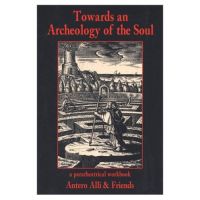Towards an Archaeology of the Soul: A Paratheatrical Workbook
by Antero Alli & Friends
Vertical Pool 2003
Antero Alli’s
Towards an Archaeology of the Soul is not an easy book to read, and this is perhaps best explained by the book’s subtitle:
A Paratheatrical Workbook. Every page of this book asks you to get up and
do, which can be quite a challenge to take sitting down.
Inspired by the groundbreaking laboratory theatre approach of Jerzy Grotowski, Alli set out to create a non-dogmatic, theatrical approach to sacred ritual. For more than two decades, Alli researched and developed a series of tools and techniques for unlocking, confronting, and embodying archetypal forces at play within the self. The first incarnation of this book,
All Rites Reversed?!, was a slim metaprogrammers’ handbook; this greatly expanded new version encompasses much more of the aesthetic, artistic currents that drive the work. Theatre is the broad context, a place where the willing suspension of disbelief allows the actor — in this case, the ritual participant — to travel across time, space, and aethyr, returning regularly to what Alli calls No-Form (the actor off stage/the absence of self) to begin again anew.
The exercises within the book span forms of initiation, “shadow work,” and distillations toward performance-worthy forms. One exercise leads you through death and rebirth; another leads you into hell and back again; and several immerse you in emotional extremes, or polarizations. “With enough discipline, talent, and emotional honesty,” Alli writes, “one can begin extracting from internal source material universal symbols, myths, and characters towards artwork and performances that elicit visceral and spiritual resonances in the audience. This is the experiment, the process and the goal.”
Throughout the years, Alli has led both performers and non-performers through paratheatrical lab sessions. “I’ve noticed that ritual labs containing mostly performing artists invariably raise the performance standards of this work,” he writes, “just as those labs containing mostly non-performers tend to deepen its spirituality.” This dichotomy characterizes the main challenge of the book: practiced artists may find the deliberate vagaries of Alli’s “just go do and see what happens” approach to be lacking in specifics, while non-artists may find the prospect of facing, and playing with, such archetypes as Death, Saviour, and Nightmare to be intimidating or bewildering. But Alli is not particularly interested in making you comfortable; quite the contrary, he is asking you to step onto a sacred-unto-itself ritual stage and take the risks inherent in being truly present in that environment.
The book is a very dry read, similar to how a book on music theory gives only the slightest hint that something potentially beautiful is being described. I can offer you this anecdotal evidence: I took a six-hour introductory workshop from Alli and experienced several of the ritual exercises described in this book first hand. As an actor, I felt challenged, often compelled, occasionally bored, and more than once, quite moved. Alli was there to remind us that we would only get out of it what we put into it, a maxim true of most things in life of course, and certainly true here. Afterward, it was clear to me that these exercises would have practical application in my life as an artist; I’ll have to take his word that these tools are useful beyond the scope of the performing arts as well.
By now, you probably know if you’re the target audience for this work, and this workbook. I once asked Alli in an interview if he thought that the use of psychedelics had an overt role in paratheatrical ritual work. He replied, “I personally would not recommend mixing these levels at the same time and place. A powerful ritual, if approached with enough self-discipline, honesty and clarity of intent is trigger enough for parting the veils.”
And that, as they say, is up to you.

